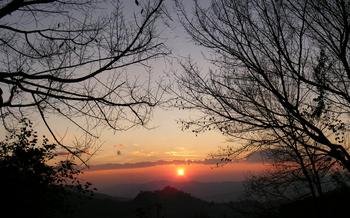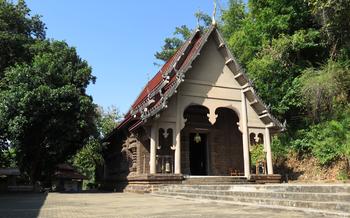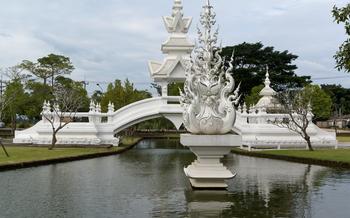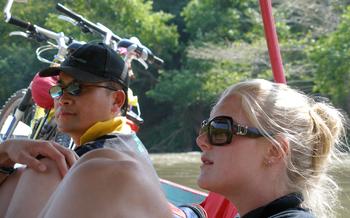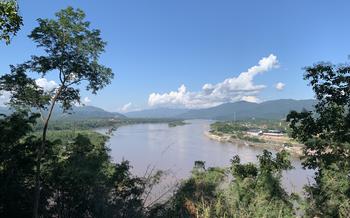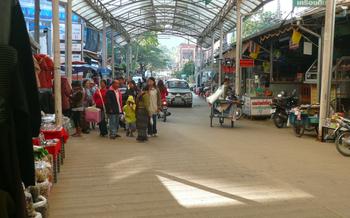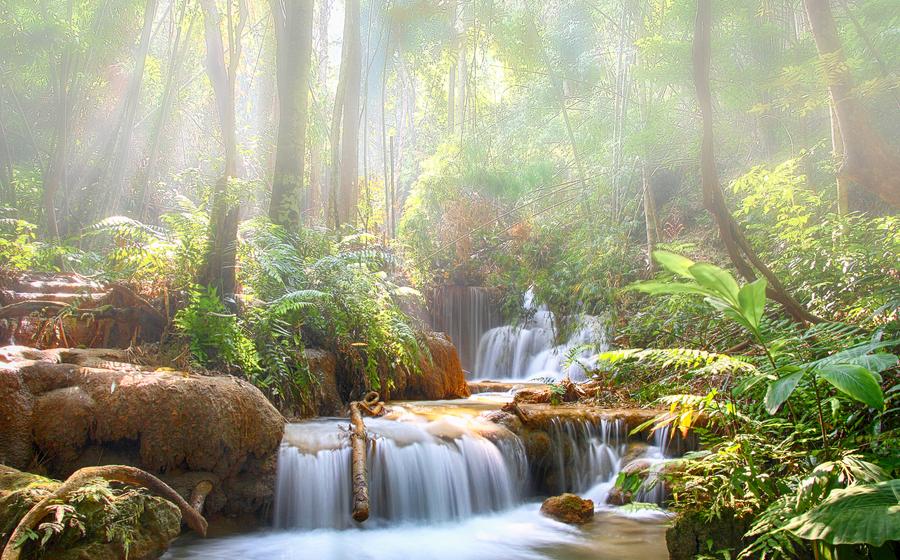
Doi Luang National Park
- Doi Luang National Park: An Overview
- Natural Wonders
- Trekking Adventures
- Doi Luang Peak: The Triumphant Summit
- Conquering the Highest Peak
- The Path to the Summit
- Breathtaking Panoramas
- A Sense of Accomplishment
- Wildlife Encounters
- Flora and Fauna: A Symphony of Life
- Waterfalls and Streams
- Cultural Heritage
- Local Communities
- Accommodation Options: Finding Your Haven in the Wilderness
- Permits and Regulations
- Best Time to Visit: Nature's Rhythm and Serendipitous Encounters
- Packing Essentials:
- Safety Tips: Ensuring a Safe and Rewarding Experience in Doi Luang National Park
- Insider Tip: Embracing the Serene Beauty of Wang Pha Phai Waterfall
Doi Luang National Park: An Overview
Nestled in the heart of Thailand's northern highlands, Doi Luang National Park is a haven for nature enthusiasts, adventurers, and those seeking tranquility. Established in 1981, the park encompasses a vast expanse of pristine forests, towering mountains, and cascading waterfalls, showcasing the country's rich biodiversity. Located in the Chiang Rai province, it covers an impressive area of 1,250 square kilometers, making it one of the largest national parks in Thailand. Doi Luang National Park is renowned for its unique ecosystem, which supports a diverse array of flora and fauna, many of which are endemic to the region. The park's significance as a protected area lies in its role in preserving the ecological integrity of this breathtaking natural wonder.
Natural Wonders
Doi Luang National Park is a treasure trove of natural wonders, captivating visitors with its breathtaking mountain landscapes, diverse flora and fauna, and unique ecosystems. The park's rugged terrain, lush forests, and cascading waterfalls create a stunning backdrop for exploration and adventure.
The park's diverse flora includes over 1,500 species of plants, ranging from towering trees to delicate orchids. Visitors can marvel at the vibrant colors of rhododendrons and azaleas, which bloom in abundance during the spring season. Among the park's unique flora is the Rafflesia kerrii, the world's largest flower, which can grow up to a meter in diameter.
The park is also home to a rich variety of wildlife, including over 300 species of birds, 70 species of mammals, and numerous reptiles and amphibians. Visitors can spot gibbons, macaques, wild boars, and even the elusive clouded leopard. The park's birdlife is particularly diverse, with highlights including the great hornbill, the emerald dove, and the scarlet minivet. The park's diverse ecosystems, ranging from tropical rainforests to montane forests, provide habitats for a wide range of species, making it a biodiversity hotspot of global significance.
Trekking Adventures
Doi Luang National Park offers a diverse range of trekking trails, catering to adventurers of all levels. From easy walks along the park's fringes to challenging treks to the summit of Doi Luang, there's something for everyone.
For beginners, the trail to Pha Chor waterfall is a great option. This relatively flat and easy trail takes you through lush forests and offers stunning views of the falls. For a more challenging experience, the trek to Doi Pha Tang is highly recommended. This trail takes you through dense jungle, bamboo forests, and across mountain streams, rewarding you with breathtaking panoramic views from the summit.
Regardless of your fitness level or experience, it is highly advisable to hire a guide for your trek. Local guides are knowledgeable about the park's terrain, wildlife, and culture, and can lead you safely to the most scenic spots. They can also help you spot wildlife, identify plants, and share insights into the local way of life.
I had the opportunity to trek to Doi Luang with a local guide, and it was an unforgettable experience. The guide led me through dense forests, pointed out rare orchids and birds, and shared stories about the park's history and legends. The highlight of the trek was reaching the summit of Doi Luang, where I was rewarded with a breathtaking 360-degree view of the surrounding mountains and valleys. It was a challenging but incredibly rewarding experience that I will never forget.
Doi Luang Peak: The Triumphant Summit
Conquering the Highest Peak
Doi Luang, the majestic peak that towers over the Doi Luang National Park, beckons adventurers with its allure of a challenging ascent and rewarding views. Standing at an impressive 1,864 meters above sea level, Doi Luang is the highest mountain in the park and the second highest in Thailand's northern region.
The Path to the Summit
The journey to the summit of Doi Luang is not for the faint of heart. It requires endurance, determination, and a strong sense of adventure. The trail winds through dense forests, crosses rushing streams, and ascends steep slopes, testing the limits of both physical strength and mental fortitude.
Breathtaking Panoramas
The arduous climb is more than worth it when you reach the summit and are greeted by a breathtaking panorama that stretches as far as the eye can see. From this vantage point, the surrounding mountains, valleys, and forests unfurl like a vast tapestry of green, dotted with colorful wildflowers and the occasional glimpse of wildlife. The views from the peak are simply awe-inspiring, making all the effort and challenges of the trek worthwhile.
A Sense of Accomplishment
Reaching the summit of Doi Luang is not just a physical achievement; it's a profound experience that leaves a lasting impression. The sense of accomplishment and exhilaration that comes with standing on top of the mountain is unparalleled, a reward that only those who have undertaken the journey can truly understand. It's a moment to savor, to soak in the beauty of the surroundings, and to reflect on the personal growth and resilience gained through the experience.
Wildlife Encounters
Doi Luang National Park is a haven for wildlife enthusiasts, offering a chance to encounter a diverse range of species in their natural habitat. From majestic birds soaring through the skies to shy mammals camouflaged in the undergrowth, the park provides ample opportunities for wildlife viewing and photography.
Birdwatchers will be thrilled by the park's rich avian diversity, with over 300 species recorded. Keep an eye out for colorful hornbills, playful sunbirds, and elegant eagles gliding on the thermals. The park is also home to several endemic bird species, such as the White-crowned Forktail and the Rufous-necked Hornbill, making it a paradise for bird enthusiasts.
For those interested in mammal watching, the park offers encounters with elusive creatures like leopards, bears, and gaur. While spotting these larger mammals can be challenging, visitors may be rewarded with glimpses of smaller mammals such as gibbons, macaques, and squirrels.
Responsible wildlife viewing is crucial to minimize disturbance to the animals and their habitat. Visitors are advised to maintain a respectful distance, avoid using flash photography, and refrain from feeding or interacting with the wildlife. By following these guidelines, visitors can contribute to the conservation of the park's rich biodiversity.
Flora and Fauna: A Symphony of Life
Doi Luang National Park is a haven for an astonishing variety of plant life. Towering trees, lush ferns, vibrant orchids, and delicate wildflowers create a tapestry of colors and textures. The park is home to unique and endangered species of flora, including the majestic Siamese rosewood, the rare butterfly orchid, and the elusive giant water lily.
The diverse plant life supports a rich and diverse array of animal life. Majestic birds soar through the skies, their songs echoing through the valleys. Colorful butterflies flutter among the flowers, adding a touch of whimsy to the landscape. Mammals such as elephants, tigers, and leopards roam the forests, while playful monkeys swing through the trees.
The park's biodiversity is of utmost importance, not only for the ecological balance of the region but also for the survival of many endangered species. Conservation efforts are diligently implemented to protect and preserve this vital ecosystem. Visitors are encouraged to respect and admire the park's flora and fauna from a distance, ensuring that future generations can continue to marvel at this natural wonderland.
Waterfalls and Streams
Doi Luang National Park is home to a network of cascading waterfalls and pristine streams that add to the park's natural beauty and charm. The sound of rushing water echoes through the valleys, creating a serene and tranquil ambiance.
Mae Puem Waterfall is one of the most popular waterfalls in the park. With its three tiers and a total height of over 100 meters, it offers a mesmerizing spectacle. Visitors can take a refreshing dip in the cool waters at the base of the falls or simply relax on the nearby rocks and enjoy the stunning views.
Other notable waterfalls in the park include Khun Kon Waterfall, Mae Kham Waterfall, and Pha Daeng Waterfall. Each waterfall has its distinct charm and offers a unique experience. Visitors can hike to the base of the falls, admire the cascading waters, and capture breathtaking photographs.
The streams that flow through the park are equally enchanting. They meander through the lush forests, creating a tranquil and serene atmosphere. Visitors can enjoy a leisurely walk along the stream banks, listen to the gentle sound of flowing water, and spot various aquatic life.
Whether you're looking for a refreshing dip, a peaceful picnic spot, or simply a place to relax and soak in the beauty of nature, the waterfalls and streams of Doi Luang National Park offer something for everyone.
Cultural Heritage
Doi Luang National Park is home to a diverse mix of ethnic minorities, each with its own unique traditions, customs, and way of life. The Karen people are the most prominent ethnic group in the area, and their villages are scattered throughout the park. The Karen are known for their distinctive colorful attire, their skill in weaving, and their traditional bamboo houses.
Other ethnic groups in the park include the Hmong, the Lahu, and the Akha. Each group has its own language, culture, and traditions. Visitors to the park have the opportunity to interact with these ethnic minorities and learn about their way of life. This cultural immersion is a valuable experience that provides a deeper understanding of the region's rich cultural heritage.
One of the best ways to experience the cultural heritage of Doi Luang National Park is to visit one of the many traditional villages. Here, visitors can see firsthand how the ethnic minorities live and interact with each other. Visitors can also purchase handmade crafts and souvenirs, supporting the local economy and preserving the traditional skills of these communities.
Local Communities
The Doi Luang National Park is home to a diverse range of ethnic minorities, each with their own unique traditions, customs, and way of life. The Karen people, known for their colorful clothing and hilltop villages, are one of the most prominent groups in the area. Visitors can learn about their culture by visiting their villages, where they can witness traditional dances, taste local delicacies, and purchase handmade crafts.
Another fascinating group is the Hmong, who migrated to the region from China in the 19th century. They are skilled silversmiths and weavers, and their intricate jewelry and textiles are highly sought after by visitors. The Lahu people, renowned for their animist beliefs and colorful festivals, also call the park area home.
Cultural immersion is a key aspect of visiting Doi Luang National Park. Visitors can engage with the local communities through guided tours, cooking classes, and homestays. These experiences provide a deeper understanding of the region's rich cultural heritage and allow visitors to connect with the people who call this special place home.
Supporting sustainable tourism initiatives is crucial for preserving the park's natural and cultural heritage. Visitors can contribute by choosing tour operators that prioritize responsible practices, respecting local customs, and supporting community-based projects. By doing so, they can help ensure that the benefits of tourism are shared equitably and that the local communities continue to thrive alongside the park's incredible biodiversity.
Accommodation Options: Finding Your Haven in the Wilderness
Doi Luang National Park offers a range of accommodation options, catering to different budgets and preferences. For those seeking a rustic experience, basic guesthouses and homestays provide a comfortable stay in the heart of nature. These accommodations offer simple rooms with shared or private bathrooms, often run by local families who can share insights into the park's history and culture.
If you prefer more comfort, resorts and lodges are available within or near the park's boundaries. These offer a variety of amenities, including private cabins or bungalows, restaurants, and guided tours. Some resorts even feature unique experiences like treehouses or jungle villas, allowing you to fully immerse yourself in the park's natural beauty.
When choosing your accommodation, consider your budget, desired level of comfort, and the activities you plan to engage in. If you're on a tight budget or prefer a more authentic experience, guesthouses or homestays are a great option. For those seeking luxury and convenience, resorts and lodges offer a comfortable and hassle-free stay.
Personal Experience: During my stay in Doi Luang National Park, I opted for a cozy homestay run by a local family. The warm hospitality, delicious home-cooked meals, and the family's knowledge of the park's hidden gems made my experience truly memorable. I highly recommend this option for those seeking a genuine connection with the local culture.
Permits and Regulations
To ensure the preservation of Doi Luang National Park and the safety of its visitors, permits and regulations are in place. Before embarking on your adventure, it's essential to obtain the necessary permits from the park authorities. The process is straightforward and can be completed online or at the park entrance. A permit fee is usually required, which contributes to the park's conservation efforts.
It's crucial to be aware of the park's rules and regulations to minimize your impact on the environment and respect the rights of other visitors. These regulations may include restrictions on camping, littering, and noise levels. Adhering to these guidelines ensures a harmonious and enjoyable experience for all.
During my visit, I witnessed the dedication of the park rangers in upholding these regulations. They were courteous yet firm in ensuring that visitors complied with the rules, which left me with a deep appreciation for their commitment to preserving this natural treasure.
Best Time to Visit: Nature's Rhythm and Serendipitous Encounters
Doi Luang National Park, like a symphony of nature, offers a unique experience in every season. The dry season, from November to April, is an ideal time for trekking, as the trails are well-maintained, and the weather is pleasant. The park comes alive during the rainy season, from May to October, with lush greenery, cascading waterfalls, and vibrant wildlife. While trekking may be more challenging due to muddy trails, the park offers a serene and tranquil ambiance.
For wildlife enthusiasts, the best time to visit is from February to April, when the animals are most active and visible. Birdwatchers will delight in the symphony of songs during the migration season from September to November. The park also hosts several cultural events and festivals throughout the year. The Doi Luang Festival, held in February, showcases the rich traditions of the local hill tribes.
No matter when you choose to visit, Doi Luang National Park offers a serendipitous encounter with nature's wonders. Whether it's the breathtaking views from the summit of Doi Luang or a chance encounter with a rare wildlife species, the park promises an unforgettable experience.
Packing Essentials:
When embarking on an adventure in Doi Luang National Park, proper preparation is key. Ensure your backpack is equipped with essential items to make your journey comfortable and safe.
-
Clothing: Breathable and moisture-wicking fabrics are ideal for trekking in the humid climate. Pack layers to adjust to changing temperatures, including a waterproof jacket for unexpected showers.
-
Footwear: Sturdy hiking boots with good ankle support are a must for navigating uneven terrain. Consider bringing sandals or water shoes for stream crossings and relaxation.
-
Gear: A backpack with ample storage space is essential for carrying supplies. Trekking poles can provide stability and reduce strain on your knees, especially during descents. A headlamp is crucial for nighttime navigation or emergencies.
-
Other Essentials: Pack a reusable water bottle to stay hydrated, a hat and sunglasses for sun protection, and a first-aid kit for minor injuries. A camera is a must to capture the park's stunning landscapes and wildlife. Consider bringing a power bank to keep your devices charged.
Safety Tips: Ensuring a Safe and Rewarding Experience in Doi Luang National Park
Doi Luang National Park is renowned for its pristine natural beauty, but it is essential to prioritize safety when exploring its wilderness. Here are some crucial safety tips to ensure a rewarding and enjoyable experience:
-
Be Prepared for the Weather: Weather conditions in the park can change rapidly, especially during the rainy season. Carry a waterproof jacket, rain gear, and sturdy footwear to navigate muddy trails. Be mindful of potential flash floods and landslides during heavy rainfall.
-
Respect Wildlife Encounters: While wildlife encounters can be thrilling, it's important to maintain a safe distance and avoid disturbing the animals. Never attempt to feed or approach wildlife, as they may perceive it as a threat.
-
Stay on Marked Trails: To minimize the risk of getting lost or encountering dangerous terrain, stick to designated trails. Avoid venturing off the beaten path unless accompanied by an experienced guide.
-
Be Aware of Your Surroundings: Keep an eye out for potential hazards such as loose rocks, slippery surfaces, and steep drop-offs. Be mindful of your surroundings and avoid distractions like using your phone while hiking.
-
Carry Essential Supplies: Pack a first-aid kit, a map, a flashlight, and a whistle for emergencies. Bring sufficient water and snacks to stay hydrated and energized during your trek.
-
Inform Others of Your Plans: Before embarking on a trek, inform a friend, family member, or park official about your itinerary and expected return time. This ensures that someone knows your whereabouts in case of an emergency.
Insider Tip: Embracing the Serene Beauty of Wang Pha Phai Waterfall
Beyond the well-traversed trails of Doi Luang National Park, there lies a hidden gem that beckons nature enthusiasts with its tranquil charm – the Wang Pha Phai Waterfall. This lesser-known cascade is tucked away in the park's lush forests, inviting visitors to immerse themselves in its serene embrace.
A leisurely walk through the verdant trails leads to the waterfall's base, where the gentle cascade of water creates a mesmerizing symphony. The pristine pool beneath the falls offers a refreshing respite, beckoning weary trekkers to take a dip and revel in the tranquil ambiance.
For those seeking a unique perspective, a short climb up the adjacent hill reveals a breathtaking panorama of the waterfall and the surrounding forest. The cascading waters seem to dance and shimmer in the sunlight, creating a mesmerizing spectacle that soothes the soul.
Whether you choose to bask in its serenity or capture its beauty through the lens, Wang Pha Phai Waterfall promises an unforgettable experience. Embrace the tranquility of this hidden gem and create memories that will last a lifetime.
